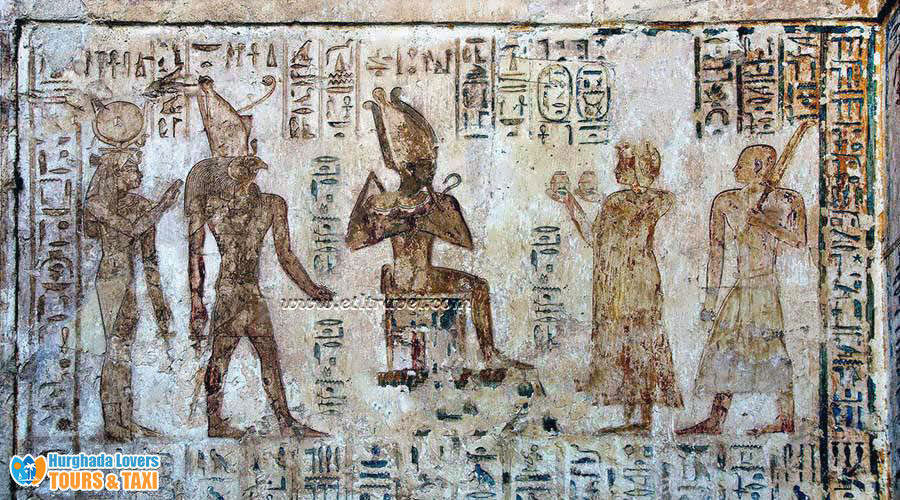Tomb of Pabasa – TT279 in Tombs of Deir Al-Madina – Theban Tombs, Luxor, Egypt – Egyptian Tombs
Facts about the construction of the most famous Egyptian Pharaonic tombs in the ancient Egyptian civilization and more about Ancient Egypt History.
He was the head and general supervisor of the temple of God Amun in the city of Nekhen during the reign of King Psamtik I of the Twenty-Sixth Dynasty of Egypt in the Late Period.
Tomb of Pabasa Facts
Discover the history of the Pharaonic civilization and the construction of the most beautiful tombs of the noble pharaohs in the necropolis of the Asasif Tombs of Deir el-Bahari.
The secrets of the most important tombs of the nobles and priests of the 26th Pharaonic Dynasty to tell us the history of ancient Egypt and the life of the ancient Egyptians in the ancient Egyptian Pharaonic civilization and what are the prices of entrance tickets and working hours and more to start your cultural tourist trip and visit the tourist attractions in Luxor and see the rare tourist attractions in Egypt.
Cemetery number= TT279.
The tomb was dug into the interior of the mountain next to the Mortuary Temple of Hatshepsut in Deir El Bahari, which was built during the reign of Queen Hatshepsut, the most famous Female Pharaohs “queen of Pharaonic Egypt” from the Eighteenth Dynasty of Egypt of The New Kingdom. Tomb of Queen Hatshepsut | KV60 is among the tombs of the Valley of the Kings.
The Pharaonic Ancient Egyptian Coffins of Babasa, made of granite (Ancient Egyptian Metallurgy), has been transferred to the Kelvingrove Art Museum, Glasgow, Scotland..
Who is Pabasa?
Pabasa is considered one of the most important nobles of the 26th Pharaonic Dynasty, as he held many prestigious positions…
Special Advisor to King Psamtik I, one of the most famous ancient pharaohs throughout ancient Egyptian history..
High priest of the Temple of Amun and the God Thoth, the most famous of the Egyptian deities – Ancient Egyptian gods and Goddesses in the Ancient Egyptian religion.
Head of the House of the Divine Worshipper of Amun Queen Nitocris I.
Decorations and inscriptions of Tomb of Pabasa:
The tomb contains wall engravings of the daily life of ancient Egyptians as well as scenes of beekeeping to tell us about Social Structure in Ancient Egypt.
You will see the drawings of Minister Babassa on the walls with the family and another inscription in the case of worshipping the god and religious beliefs of the pharaohs..
Map of the interior of the Babasa Tomb:
The tomb is designed in a subterranean style, starting with a staircase downwards, then a brick gate with an inscription and texts in ancient Egyptian hieroglyphics, then a 4-meter-long staircase downwards leading to the burial chamber..
On the walls of the small hall you will see an engraving of the funeral procession of Babsa with the presence of a group of people and the god Abydos.
There are texts in hieroglyphics “Ancient Egyptian Language” and drawings of the presence of his son Thorbakhebish while attending the stages of his father’s burial, indicating the development of Sculpture in Ancient Egypt and the art of Architecture in ancient Egypt.
You will see an inscription above the inner threshold showing the God Osiris and Re-Horakhty with the vizier Papassa and Nitocris, and the text of the pharaonic Egyptian Cartouche of King Psamtik I and his daughter Nitocris on the walls..
Sun Hall – Open Sun Courtyard in the Sky:
You will see 3 square columns with a carving of the daily life of the ancient Egyptians, as it contains a carving of a bedroom being prepared for use, a carving of men’s isolation, the process of cleaning fish, and catching birds with a stick in the ancient Egyptian civilization..
Burial chamber:
Inside the burial chamber of Papasa, you will notice on the walls of the room a unique and distinctive Pharaonic engraving of the stages of beekeeping among the ancient Egyptians, planting grapes and harvesting fruits, in addition to a group of hieroglyphic engravings and texts of the minister Papasa on the walls of the courtyard to tell us about how Agriculture in Ancient Egypt.
The tomb contains a large hall based on 8 columns decorated with inscriptions and decorations of the gods and ancient Egyptian beliefs, but they are not clear, then the burial column of Papasa.
What are the Asasif Tombs?
It is a group of tombs belonging to the upper class in the ancient Pharaonic civilization known as the nobles from the 18th dynasty, Twenty-fifth Dynasty of Egypt, the era of the Black Pharaohs, 26, dated 1550 – 525 BC..
The Asasif Necropolis is located in the western area of Luxor on the Nile River, known in ancient times as the city of Thebes in southern Egypt. The area was chosen next to the Dra Abu el-Naga cemetery..
The Asasif Tombs contain more than 30 coffins of the High Priest of Amun, senior state officials in ancient Egypt “Ancient Egyptian Government“, and children from the Twenty-second Dynasty of Egypt.
Babasa Cemetery Address:
Asasif Necropolis Deir el-Bahari Tombs in Luxor Egypt.
Visiting hours:
Daily 6:00 AM – 8:00 PM
Entrance ticket prices:
Note: Facts and secrets of the history will be added soon…
Hurghada Excursions Lovers, Best Travel Agency in Hurghada to provide daily tours to visit the Tourist attractions of Luxor by Hurghada to Luxor Tours and Hurghada to Pyramids Trips. Book online when you come to Hurghada, El Gouna, Sahl Hashish, Makadi Bay, Soma Bay, Egypt Tours Packages.
